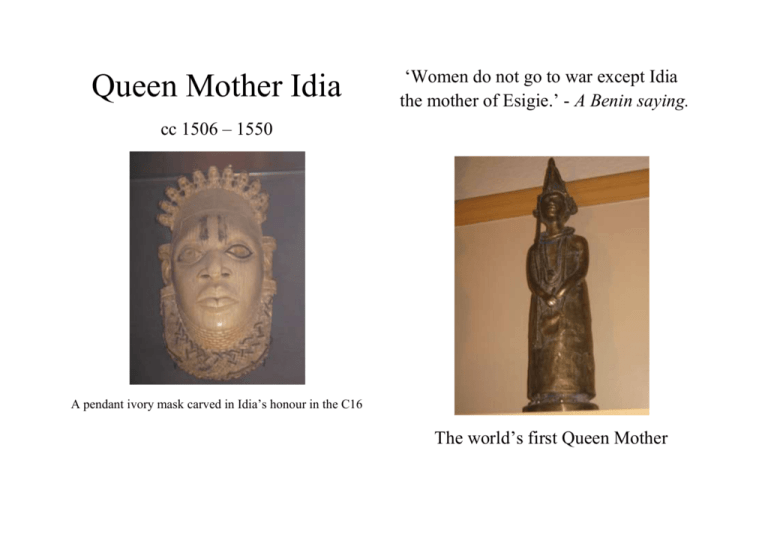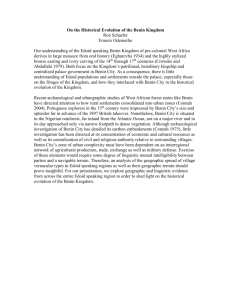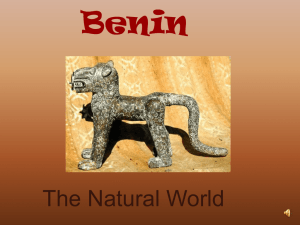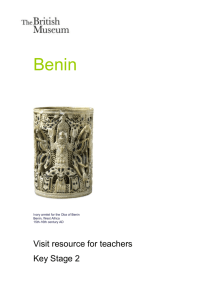File - Kingdom of Benin
advertisement

Queen Mother Idia
‘Women do not go to war except Idia
the mother of Esigie.’ - A Benin saying.
cc 1506 – 1550
A pendant ivory mask carved in Idia’s honour in the C16
The world’s first Queen Mother
After the death of Oba Ozolua (1481- 1504) a
power struggle ensued between his two sons,
Prince Osawe who ascended the Benin throne as
Oba Esigie and his half-brother Arhuanran who
was at that time ruling another powerful town Udo
some 20 kilometres outside Benin City. However
he ruled as a duke not a king.
cried out and was reported to the king who
performed proclamation rites to declare him heir to
the throne. Prince Arhuanran and his mother were
unhappy and continued to dispute this position of
the rightful heir to the throne, claiming denial of
Prince Arhuanran’s birthright. So when his father
the Oba died, he made a claim on the throne.
Idia is accredited with aiding her son to secure his
claim to the throne and for providing him with
ongoing support and wise counsel throughout his
reign. His kingship survived because of her efforts.
This led to a long and bloody civil war, on record
as one of the bloodiest wars in the kingdom’s
history. The king’s mother concerned about
survival of her son’s monarchical authority and of
Benin kingdom, supported him to launch a full
scale war on Udo. Oba Esigie won.
Since the time, they were born, there existed a
dispute about who was the rightful heir to the
throne. According to Benin tradition, the first born
son always succeeds the throne. However, two of
the Oba’s wives gave birth to male sons hours
apart. As per Benin tradition, the first son to cry is
the senior child. Prince Arhuanran was born first
by his mother, however, he did not cry out and
when a few hours later Prince Osawe was born, he
The Udo wars led to the defeat of his rebel halfbrother and extension of Benin Kingdom domain.
Benin royal army built military camps (Eko) on
their way to their many war campaigns which were
often over long distances. Frequently on their way
back from the war, some of the leaders chose to
settle down in these camps and not return to Benin.
From the Udo wars originated new settlements
amongst them Eko (now Lagos) and Ondo. These
are now Yoruba lands.
Exploiting weaknesses in the kingdom during this
civil war, Igala people sent soldiers across the
Benue River to colonise northern parts of Benin
kingdom. A long and bloody war ensued Benin
Royal troops assisted by Portuguese mercenaries
defeated the Igala
people (1516).
Here a Portuguese
has been casted in
Benin Bronze plaque
with his matchlock
gun. The Portuguese
mercenaries trained
Benin Royal army
and assisted in many
Benin wars.
Idia is credited with using her knowledge of
magical powers and medicinal knowledge to lead
the troops when they fought and pursued the Igala
soldiers from the kingdom.
The Igala king was captured and taken to Benin,
where he pledged annual tribute to Oba Esigie for
the transgression.
The majority of the Igala soldires were lost during
the war, a handful of them managed to escape by
jumping into the Benue River and swimming
across. As the Benin soldiers could not swim to go
after them, they got away.
Captured in war kings were brought back to Benin
to pledge annual tribute as vassals to the kingdom.
With security and peace in the kingdom, Oba
Esigie was able to direct his attention to other
matters. He expanded Benin territory. He
established Christianity in the kingdom and
exchanged ambassadors with the king of Portugal.
He received explorers like John Affonso d'Aveiro.
Oba Esigie could read and write Portuguese
fluently. His heir was educated under the
Portuguese education system.
In honour of her support, Oba Esigie created the
title of Iyoba (Queen Mother) granting her equal
authority to that of a senior town chief (these chiefs
help the king run the towns).
He built a palace for her Eguae-Iyoba at Eselu
(lower Benin). Eguae-Iyoba translates as Queen
Mother city. From here, she exercised a lot of
political influence in the administration of the
kingdom as she had her own domain. This
arrangement avoided conflict with the Oba’s
authority. She had the power to nominate worthy
citizens for conferment of special Queen Mother
Palace titles.
Oba Esigie commissioned a brass head which
represented her to be made and placed on her alter
following her death.
From this period onwards, shortly after the
coronation of an Oba, the title of Queen mother is
conferred on his mother.
All Queen Mothers are buried in a special burial
place in Eguae-Iyoba.
All queen mothers were viewed as instrumental to
the protection and well being of the Oba and
ultimately of the kingdom.
Queen Mother Idia has remained an inspirational
female role model for subsequent queen mothers
and all mothers in the kingdom.
In the old kingdom, Queen Mothers were viewed
as special and they devoted their time entirely to
raising the next king in accordance with traditions.
As one of the few successful military women in
world history, her place is rightfully alongside Joan
of Arc (1430) , Samurai Hangaku Gozen (1201)
and Boudica Celtic Britain (60AD) to name but a
few.
Iyoba (Queen Mother) Timeline
1506 to present
Iyoba {Queen
Mother}
Mother Of Oba
Idia
Esigie
Elaba
Umelu
Orhogbua
Ehengbuda
Ohuan
Ahenzae
Akenzae
Akengboi
Ahnkpaye
Akengbedo
Oreoghene
Ewuakpe
Ozuere
Akenzua I
Erosoyen
Akengbuda
Obanosa
Ogbebo
Osamwede
Adolo
Ovonramwen
Eweka II
Akenzua II
Erediauwa
-----Eson
Efeseke
Enahen
Edia I
Ohogha I
Imarhiaede
Ewebonoza
-----Iha I
Ede
Ohogha ll
Ose
-----Omozogie
Ugiomo
Ihaya II
Eghaghe
Ariowa
Aghahowa
Source: edoworld.net
Period
About 15061550AD
,, 1550-1578AD
,, 1578-1606AD
,, 1606-1614AD
,, 1614-1661AD
,, 1661-1669AD
,, 1669-1675AD
,, 1675-1684AD
,, 1684-1689AD
,, 1689-1700AD
,, 1700-1712AD
,, 1712-1713AD
,, 1713-1735AD
,, 1735-1750AD
,, 1750-1804AD
,, 1804-1816AD
,, 1816-1816AD
,, 1816-1848AD
,, 1848-1888AD
,, 1888-1914AD
,, 1914-1932AD
,, 1933-1978AD
,, 1978-Date
Source: edounionsweden.se
Queen Mother Idia
An inspirational role model for all women
The epitome of motherhood










